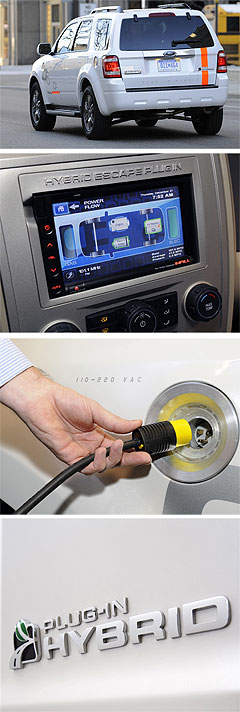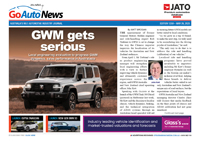Future models - Ford - Escape - Plug-In HybridGreen Fields outlines problems with plug-in hybridsHurdles: Ford's Escape Plug-In Hybrid is under development. Ford Motor Co exec calls for US government action in no-nonsense hybrid speech17 Jun 2008 By TERRY MARTIN THE Ford Motor Company’s president of The Americas Mark Fields has cast doubt over mass-market introduction of plug-in electric hybrid vehicles in the near future, outlining a number of engineering challenges, battery development problems and infrastructure complexities. In a speech delivered at a plug-in electric vehicles conference in Washington last week, Mr Fields used Ford’s experience with the Escape Plug-In Hybrid now in development – which uses lithium-ion batteries sourced from Johnson Controls-Saft – to illustrate problems with plug-ins and to emphasise that “multiple technology paths” across a range of vehicles rather than a “silver bullet solution” were being pursued. These include the introduction of direct-injection turbo engines, “clean” diesel engines, expanded use of six-speed automatic gearboxes and new hybrid models.  With plug-in hybrids, Mr Fields said Ford had experienced a number of engineering difficulties and that solutions were needed for systems that would traditionally rely on a conventional engine, including emissions control, transaxle lubrication and even cabin features like window defrost and heating. With plug-in hybrids, Mr Fields said Ford had experienced a number of engineering difficulties and that solutions were needed for systems that would traditionally rely on a conventional engine, including emissions control, transaxle lubrication and even cabin features like window defrost and heating.“We’ve been working on these and other technical hurdles, and we’re confident that we have the expertise to properly design a robust plug-in hybrid,” he said. “But in order to deliver plug-in hybrids to the mass market, challenges that lie outside of the automotive realm must be addressed. Viable solutions to these issues can only come from partnerships with other sectors of the marketplace. “First, there’s the battery. The advancement in lithium-ion technology is what makes plug-in hybrids possible, but the technology is still new for vehicle applications. Will lithium-ion batteries prove durable – especially when they’re subjected to the vibrations and bumps of 150,000 miles of real-world use? Will they meet customer expectations in the extremes of a Minnesota winter and an Arizona summer? Will the packaging and controls provide the level of quality and safety that consumers demand, and expect, from our products? “While they are getting closer, battery manufacturers have a ways to go before they can commit to providing batteries that meet OEM safety and durability requirements at a cost and volume necessary to support substantial production – and at a level that would affect national petroleum consumption and carbon dioxide emissions. Will the batteries be able to do all that and be affordable to the average consumer? “It’s also important to note most battery supply is currently being developed in Asia. For those looking to plug-ins to answer our energy security concerns, we must ensure a domestic battery supply. Moving from imported oil to imported batteries clearly would not address this growing concern. “ Mr Fields said the other major pre-requisite for commercial viability was a “robust recharging infrastructure”. Among the factors that needed to be solved was access to a garage, the need for a public recharging infrastructure for plug-in hybrids – which are currently nonexistent – and payment issues. “When you’re not at home, how do you pay for the electricity you use to recharge your vehicle, or for that matter, how do you know how much that electricity will cost? Rates vary from region to region, and soon – from hour to hour,” Mr Fields said, adding that in contrast to the handful of petroleum companies there were literally thousands of electricity utilities “which would need to unite in recharging protocols and billing to provide the seamless infrastructure needed for a mass market”. Mr Fields called on the US federal government to accelerate commercialisation of plug-in hybrids through greater investment, tax breaks and policy initiatives, such as creating incentives for lithium-ion battery production in the US. “Based on the necessary research and development costs, manufacturing and production investments, the lack of a national refuelling infrastructure, and the lack of domestic battery manufacturing, it seems clear that a business case will not evolve, in the near term, without support from Washington,” he said. “The governments of Japan, China, Korea, and India are significantly funding the research development and deployment of plug-in hybrid vehicle technologies. This is a race that we must win. We should not trade one foreign energy dependency for another. “Key actions the government can take include: creating a new industry/government partnership to aggressively advance battery research, development and commercialisation injecting significant federal funds into advanced plug-in vehicle technologies and into facility retooling to produce these vehicles enacting comprehensive climate change legislation requiring regulatory policies that stimulate innovation, rather than just imposing new mandates and, enacting one national standard for fuel economy – rather than allowing a patchwork of state and federal regulations,” he said. “Today, we’re at an important juncture. Continued government investment, incentives for industry to continue pushing on research and development of this emerging technology and rewards for customers who incorporate it into their lives are the keys to real and lasting change – and a future of greater energy independence in which we can all thrive.” Escape pricing
Motor industry news |
Click to shareFord modelsResearch Ford Escape pricing
Motor industry news |














Facebook Twitter Instagram